Human Orbital Spaceflights
![]()
International Flight No. 48Soyuz 13KavkazUSSR |
|
![]()
Launch, orbit and landing data
|
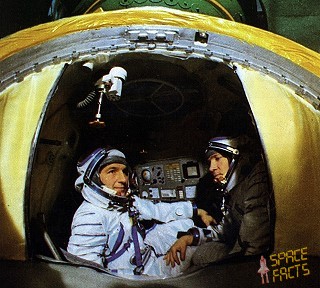 |
|||||||||||||||||||
alternative crew photo |
alternative crew photo |
|||||||||||||||||||
alternative crew photo |
alternative crew photo |
|||||||||||||||||||
alternative crew photo |
alternative crew photo |
|||||||||||||||||||
Crew
| No. | Surname | Given names | Position | Flight No. | Duration | Orbits | |
| 1 | Klimuk | Pyotr Iliyich | Commander | 1 | 7d 20h 55m 35s | 127 | |
| 2 | Lebedev | Valentin Vitaliyevich | Flight Engineer | 1 | 7d 20h 55m 35s | 127 |
Crew seating arrangement
|
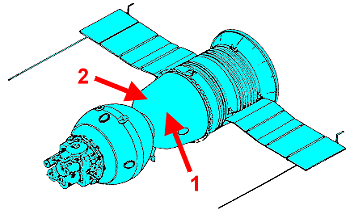 |
|
||||||||||||
Backup Crew (only "on paper")
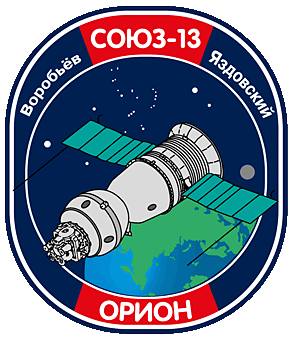 |
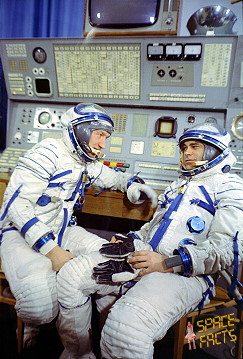 |
|||||||||||||||
alternative crew photo |
Backup Crew (in fact)
|
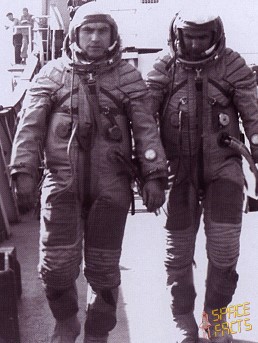 |
Hardware
| Launch vehicle: | Soyuz (No. S15000-28) |
| Spacecraft: | Soyuz 13 (7K-T No. 33) |
Flight
|
Launch from the Baikonur Cosmodrome; landing
200 km southwest of Karaganda. Lev Vorobiyov and Valeri Yazdovsky were assigned for Soyuz 13, but the crew members had personal differences and the planned prime crew was then grounded. According to a Russian source Vorobiyov himself told that after the crew was replaced, he and Yazdovsky refused to duplicate and withdrew from further flight training. Therefore, they remained stand-ins only "on paper." In fact, the understudies were Kovalyonok-Ponomaryov. Soyuz 13 performed a unique test flight of the 7K-T/AF modification of the Soyuz spacecraft. On board was the large Orion 2 astrophysical camera. The crew performed astrophysical observations of stars in the ultraviolet range with this camera. The Orion 2 Space Observatory, designed by Grigor Gurzadyan, was operated by crew member Valentin Lebedev. Ultraviolet spectrograms of thousands of stars to as faint as 13th magnitude were obtained by a wide-angle meniscus telescope of the Cassegrain system, with an aperture diameter of 240 mm, an equivalent focal length of 1,000 mm, and a 4-grade quartz prism objective. The dispersion of the spectrograph was 17, 28 and 55 nm/mm, at wavelengths of 200, 250 and 300 nm respectively. The first satellite UV spectrogram of a planetary nebula (IC 2149 in Auriga) was obtained, revealing lines of aluminium and titanium - elements not previously observed in objects of that type. Two-photon emission in that planetary nebula and a remarkable star cluster in Auriga were also discovered. Additionally, comet Kohoutek was observed. Spectrozonal Earth photography, testing of on-board systems and biological explorations (OASE 2) in view of later planned long termed missions were other experiments. Some of this experiment should have been done on the Salyut 2 station, but the station failed in orbit. The Soyuz spacecraft is composed of three elements attached end-to-end - the Orbital Module, the Descent Module and the Instrumentation/Propulsion Module. The crew occupied the central element, the Descent Module. The other two modules are jettisoned prior to re-entry. They burn up in the atmosphere, so only the Descent Module returned to Earth. The deorbit burn lasted 188 seconds. Having shed two-thirds of its mass, the Soyuz reached Entry Interface - a point 400,000 feet (121.9 kilometers) above the Earth, where friction due to the thickening atmosphere began to heat its outer surfaces. With only 23 minutes left before it lands on the grassy plains of central Asia, attention in the module turned to slowing its rate of descent. Eight minutes later, the spacecraft was streaking through the sky at a rate of 755 feet (230 meters) per second. Before it touched down, its speed slowed to only 5 feet (1.5 meter) per second, and it lands at an even lower speed than that. Several onboard features ensure that the vehicle and crew land safely and in relative comfort. Four parachutes, deployed 15 minutes before landing, dramatically slowed the vehicle's rate of descent. Two pilot parachutes were the first to be released, and a drogue chute attached to the second one followed immediately after. The drogue, measuring 24 square meters (258 square feet) in area, slowed the rate of descent from 755 feet (230 meters) per second to 262 feet (80 meters) per second. The main parachute was the last to emerge. It is the largest chute, with a surface area of 10,764 square feet (1,000 square meters). Its harnesses shifted the vehicle's attitude to a 30-degree angle relative to the ground, dissipating heat, and then shifted it again to a straight vertical descent prior to landing. The main chute slowed the Soyuz to a descent rate of only 24 feet (7.3 meters) per second, which is still too fast for a comfortable landing. One second before touchdown, two sets of three small engines on the bottom of the vehicle fired, slowing the vehicle to soften the landing. The recovery of the capsule was problematic because of a snowstorm. |
Photos
 |
 |
 |
 |
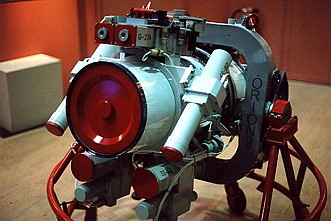 |
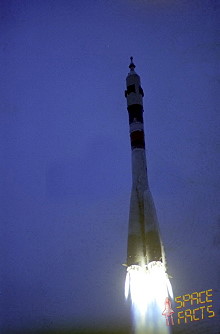 |
 |
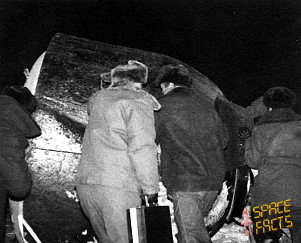 |
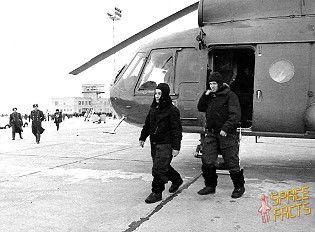 |
| © |  |
Last update on January 05, 2026.  |
 |